Borobudur is the oldest Buddhist temple in the world and one of the most majestic ones. It is situated on Java Island, Indonesia. The period of construction: 750-850 AD. Its name is translated as “the Buddhist temple on the mountain”. It is the second largest Buddhist temple in the world after Angkor Wat. Constructors erected this monument in the shape of a mandala and an opening Lotus flower on a square base (118 x 118 m) that smoothly turns into a circle.
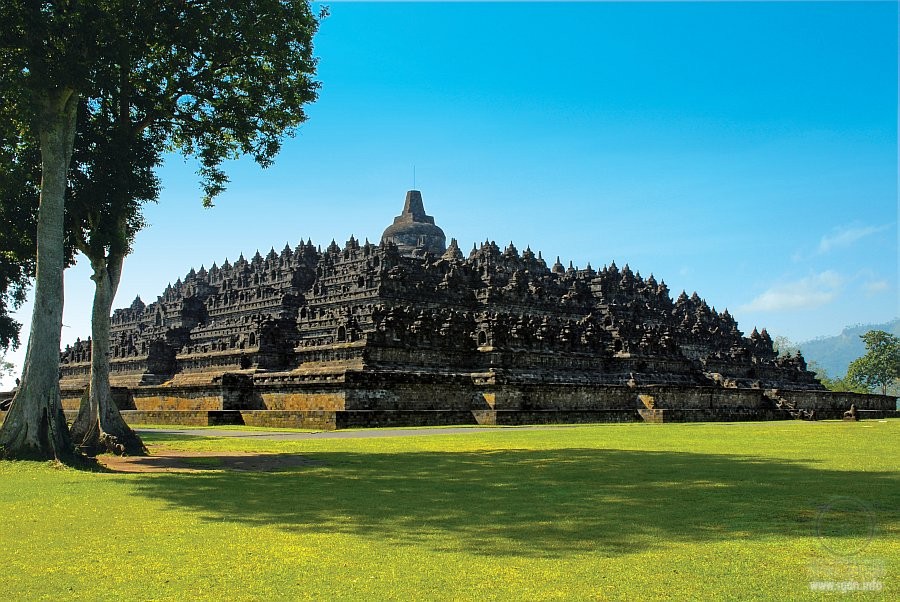
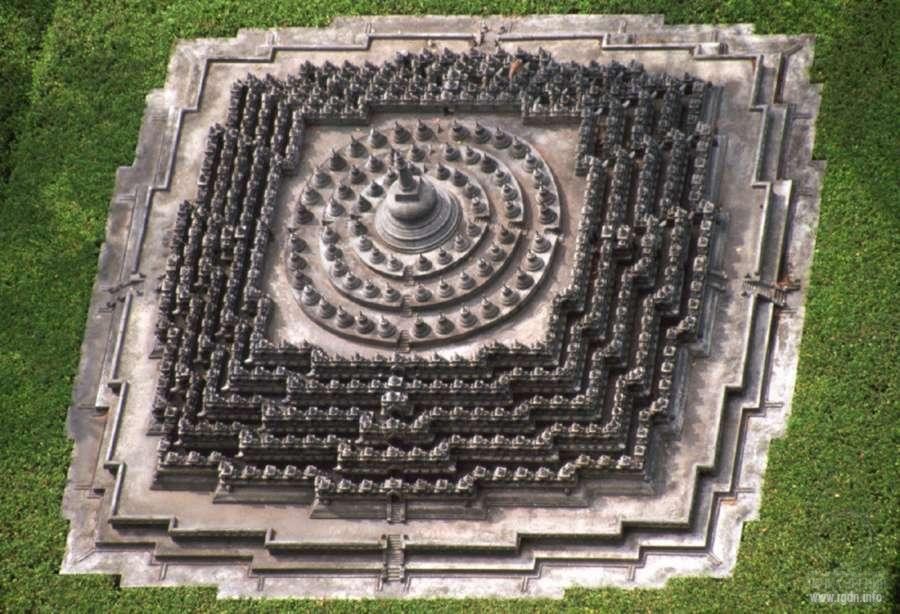
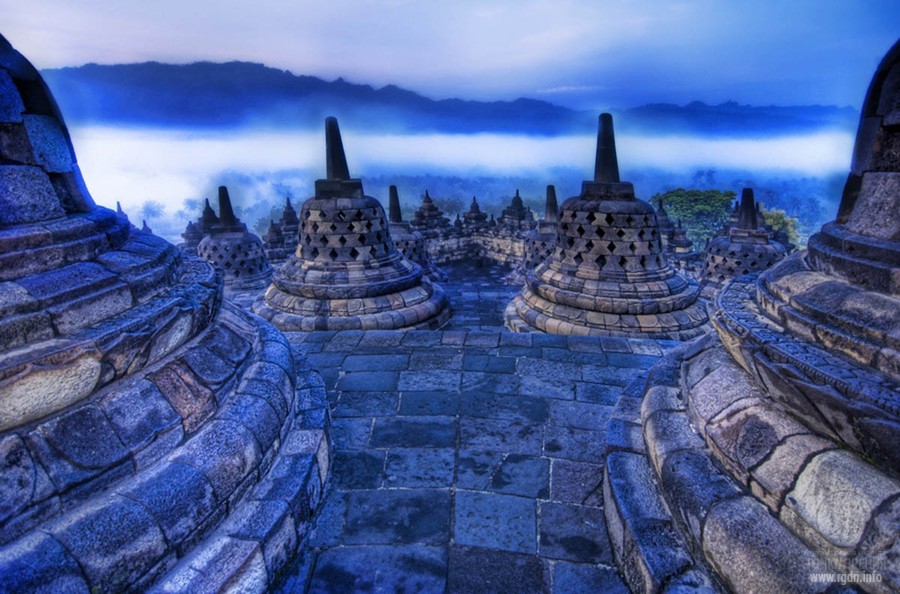
From the AllatRa book (pages 501-503 – allatra.us):
Rigden: At that, one who has reached spiritual heights does not need words, because such person acquires inner spiritual understanding of the very essence of this phenomenon… In Buddhism, for example, the spiritual “centre” means Nirvana, Enlightenment. By the way, as I once told you, in this religion, in certain visual meditative practices they use a mandala (translated from Sanskrit, it means “a circle”, “a sphere”) – a schematically drawn geometric composition or structure that symbolises the spiritual and cosmic order of the Universe, as aspiration for the spiritual centre which gives the clarity of Enlightenment. But what particular form does it have? Usually, it is a circle within a square, or triangles which most often point downwards, with the central symbol (a circle) in the middle. As a rule, a mandala is divided into four parts or into a number of parts divisible by four. Or let us take a yantra (“an amulet”, “a magic drawing” when translated from Sanskrit), which is the simplest form of a mandala. It is a schematic drawing of a composition of geometric shapes, which is used in meditation practices in Hinduism and Buddhism to intensify processes of inner concentration during meditation. As a rule, it represents circles, triangles, a symbolic image of a lotus or a point (the centre, zero point), inscribed in a square. Again, if we speak of the symbolism of monumental structures, the architectural layout of most Hindu, Buddhist, and Jain temples represents yantras.
Generally speaking, it should be noted that the quadratic structure, which points at the common ancient symbolism of spiritual knowledge, is reflected in the architectural layout of temples belonging to other religions as well. For instance, temple and monastery complexes in Ancient China had a square and a circle in their base. Thus, the largest and famous Temple of Heaven is divided into two parts in its layout: one is shaped as a square (a symbol of the Earth; earthly powers) and the other one is rounded (the circle is a symbol of Heaven; heavenly forces). In China, a joint image of a square and a circle (Earth and Heaven) still symbolises an ideally balanced person (in the spiritual aspect). Another example: the form of Muslim mosques, which are oriented towards the Kaaba in Mecca, is also square or rectangular…
Anastasia: Yes, once you told us about this, and regarding Christian temples, too. A Christian quadrifolium (“four-leaved clover”, from the Latin word quadri meaning “four times” and folium meaning “a leaf”) is a cross-in-square temple, the four branches (bays) of which are crowned with dome-shaped curves denoting the “firmament”. You mentioned that the Greek name of such temples was tetraconch (“four shells”; from the Greek word tetras meaning “four” and konche – a “shell”, a “whirlwind”, “what is spirally twisted”). I got interested in it and discovered many interesting facts. Such structures were popular not only in ancient Rus, but also in the Byzantine Empire, Transcaucasia countries (Armenia and Georgia), Persia (Iran), India, and other ancient lands. They came to the West through the Hellenistic culture, which had borrowed many things from the cultures of the ancient East. But what’s remarkable is that in early Christian temples of the Middle East and Europe (and later in Christian temples of ancient Rus as well) the altar at first was installed exactly at the templeCrossing as a throne of the “invisible God”! That is, under the central big dome in the middle of the church. And only much later was the altar moved to the protruding eastern part of the building.
Borobudur has eight tiers: the five lower ones are square, whereas the three upper ones are round. The shape of the building itself resembles a mandala and represents a scheme of the universe according to Buddhist beliefs, where heaven and earth are united. On the upper tier there are 72 small stupas around a big central stupa. Every stupa is bell-shaped. Inside the stupas, there are Buddha statues.
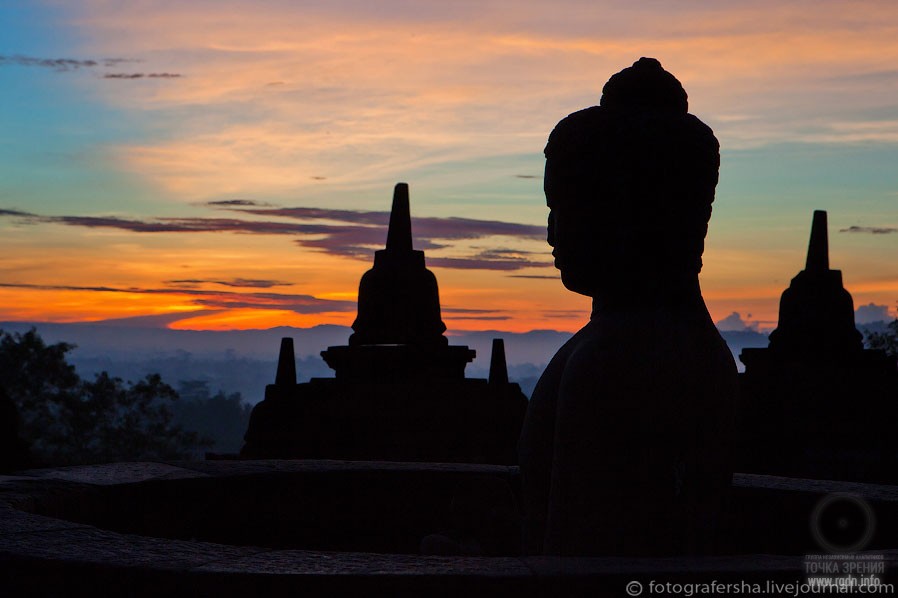
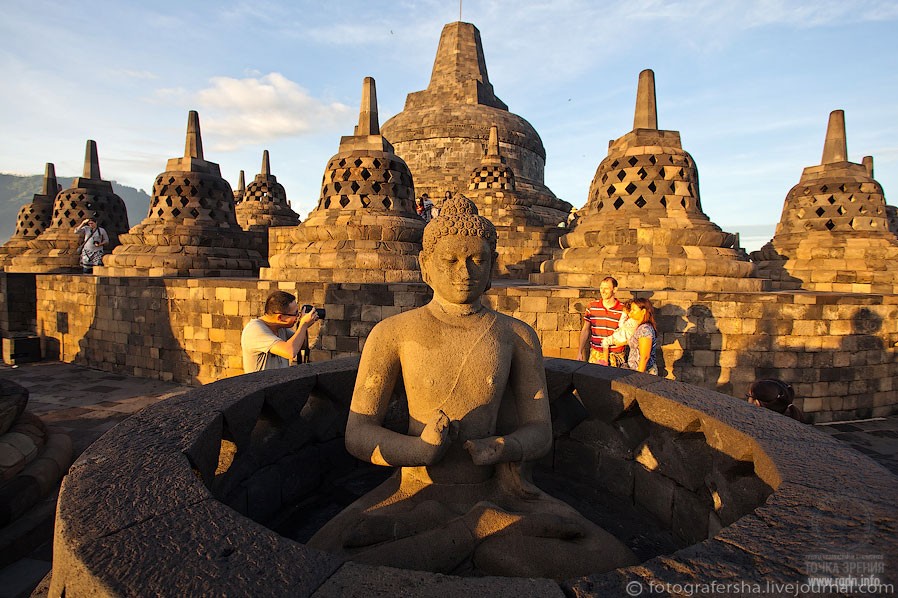
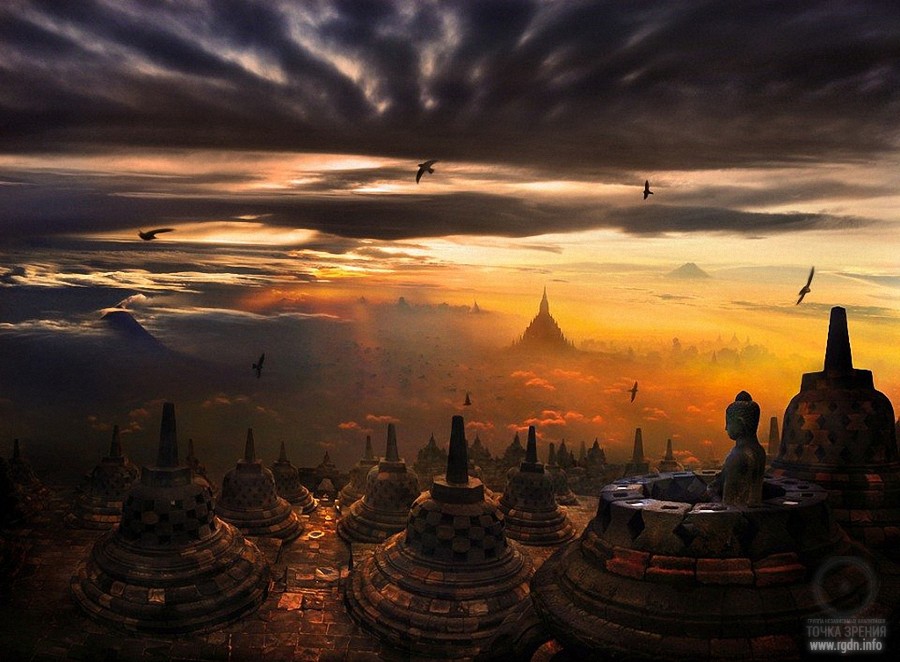
The temple complex contains 1,460 bas-reliefs with religious motifs. Relief panels describe the world of passions and the world of human perceptional development. Gradually ascending the helical serpentine road, a traveller perceives the world of matter and reaches the spiritual world.
The temple structure may be divided into three components:
The temple base is 118 x 118 m in width and 4 m in height. It is made of smooth plates with three tiers and 20 corners. The temple body consists of five square platforms-tiers: the higher one ascends the smaller every next tier is. The very first platform of the “monument body” is located 7 metres away from the edge of the base. Every subsequent platform is shifted 2 metres relative to the previous platform. The temple summit consists of three rounded platforms, on which 72 small stupas and the main stupa in the centre are installed. The central stupa is the highest point of the monument, towering 35 metres above the temple foot. It represents a bell-shaped stupa, 7 metres in height, topping the huge pyramid.
The lowest level of the temple complex, called Kamadhatu, represents the world of passions. 160 images of sensory manifestations have not been preserved to nowadays – we know about the existence of those from ancient manuscripts only.
The second level – the five tiers called Rupadhatu – symbolizes the real world and contains religious themes. The entire history of Buddhism is reflected in sculptures and bas-reliefs. Here, there are 432 Buddha statues: 104 on the first and second terraces (each), 88 on the third terrace, 72 on the fourth, and 64 on the fifth.
The remarkable beauty is completed by the three upper rounded terraces. This is the Arupadhatu level. There are 32 stupas on the lowest terrace, 24 on the middle, and 16 on the upper. A natural-sized statue of Buddha is inside each of the stupas. The largest stupa – the symbol of eternity – finishes the building.
32+24+16 = 72: an interesting interpretation of the structure of the world.
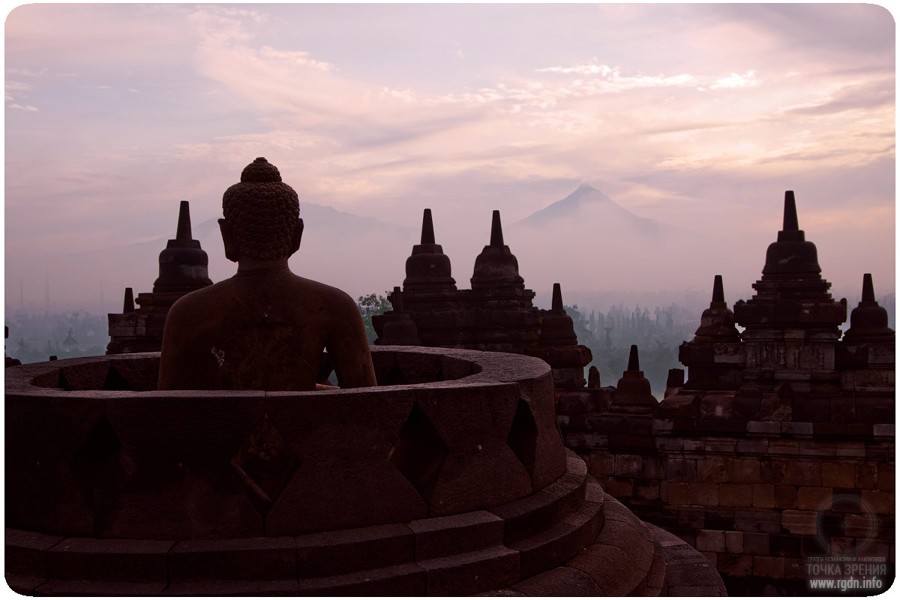
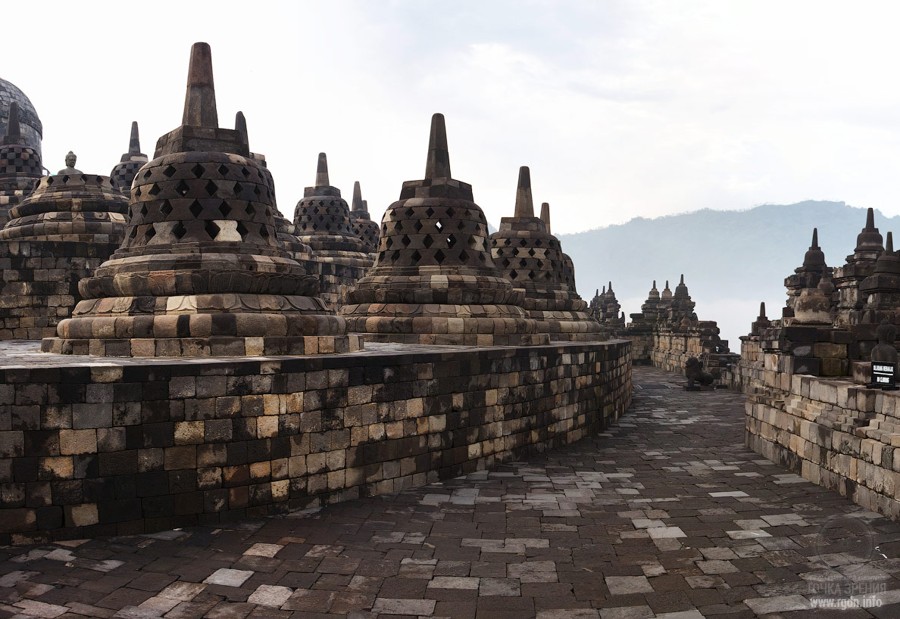
The most interesting is the secret of the “tenth terrace”. It was discovered totally accidentally that bas-reliefs are carved under the ground on Borobudur base walls, just like on the six lower terraces of the stupa. About 1,500 square metres of valuable bas-reliefs have turned to be hidden under the ground. The lower tier of the bas-relief describes the afterlife, and we can assume this was the reason why human eyes were not supposed to see it. An enormous piece of work was deliberately concealed from people, since only all-seeing deities could admire the bas-reliefs.
Here is a panoramic view of the upper tiers and the largest stupa:
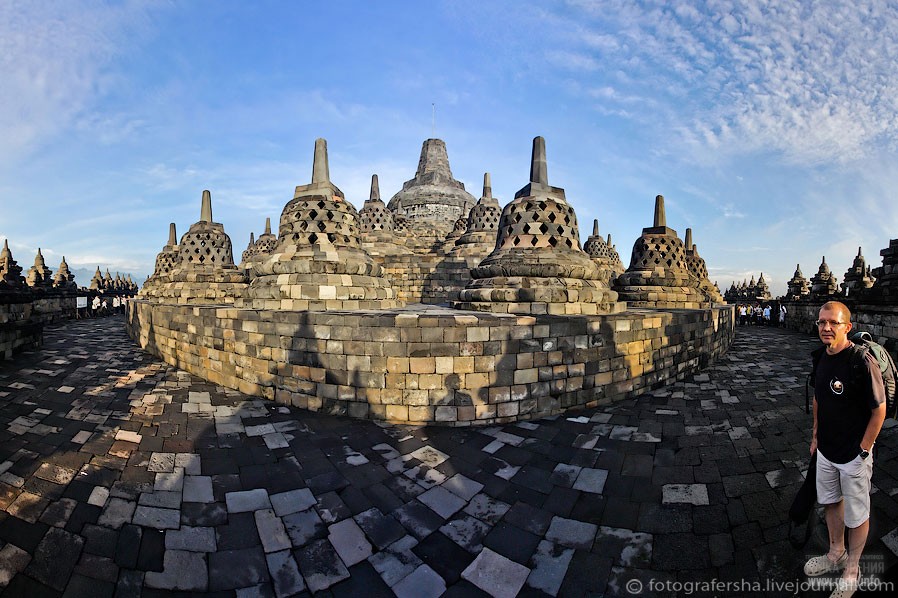
The solidity of the bas-reliefs captured my imagination, and for some reason I recalled Angkor Wat (see photos):
There is an assumption that Borobudur was constructed in a shape of Buddha sitting on a Lotus flower. In 1949 geologists discovered deposits that were interpreted as the bottom of a lake. There is a probability that the temple complex was located on a lake. By the constructors’ plan, the entire magnificence of the temple was above the lake surface, and Buddha statue crowned the entire structure.
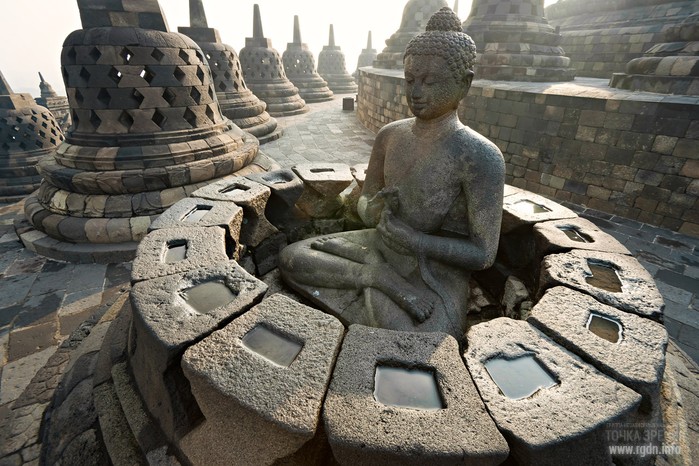
Buddhist monks who were building Borobudur implemented the idea of “a bible in stone”, having left the knowledge to descendants for many centuries. Images on the walls told about Buddha’s life. Following the way along the galleries, a person approached enlightenment. In order to read this textbook in stone, one needed to cover almost 5 km. Visitors covered the way to the very top of the temple, moving clockwise through all the eight tiers. Every platform represents a stage of education on the way of transition from the earthly plane to the heavenly plane.
At first sight, all statues of Buddha look alike, but there is a subtle difference between them in a certain position of Buddha’s hands (in Buddhism such hand position is called mudra). In Mahayana (one of the two major branches of Buddhism) there are 5 groups of mudras: the north, the east, the south, the west, and the highest point (zenith). The north, the east, the south, and the west indicate not spatial directions, but the sequence of movement, expressed in a relevant position of hands. Such movement, just like the movement of the sun, starts in the east. Hence, the main entrance to Borobudur is located on the eastern side, where the sun rises.
On the eastern side Buddha’s hands touch the ground:
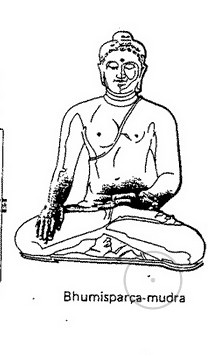
In the south his hands are raised:
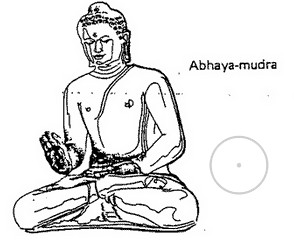
In the west his arms are folded below his chest:
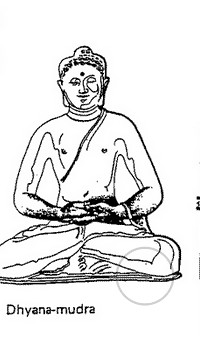
In the north Buddha’s left hand is put on the knee, while his right hand is lifted in a placatory gesture:
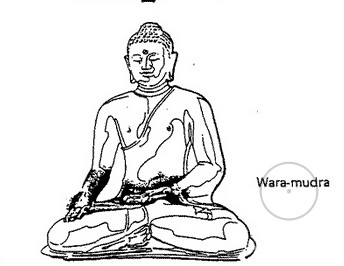
The position of Buddha’s hands on the fifth balustrade and inside the 72 stupas on the upper rounded platforms embodies the highest point in Buddha’s life, when he delivered his first sermon in Sarnath after achieving enlightenment.

Every mudra embodies one of the five Dhyani Buddhas that symbolize five aspects of the Supreme Wisdom of the initial Buddha.
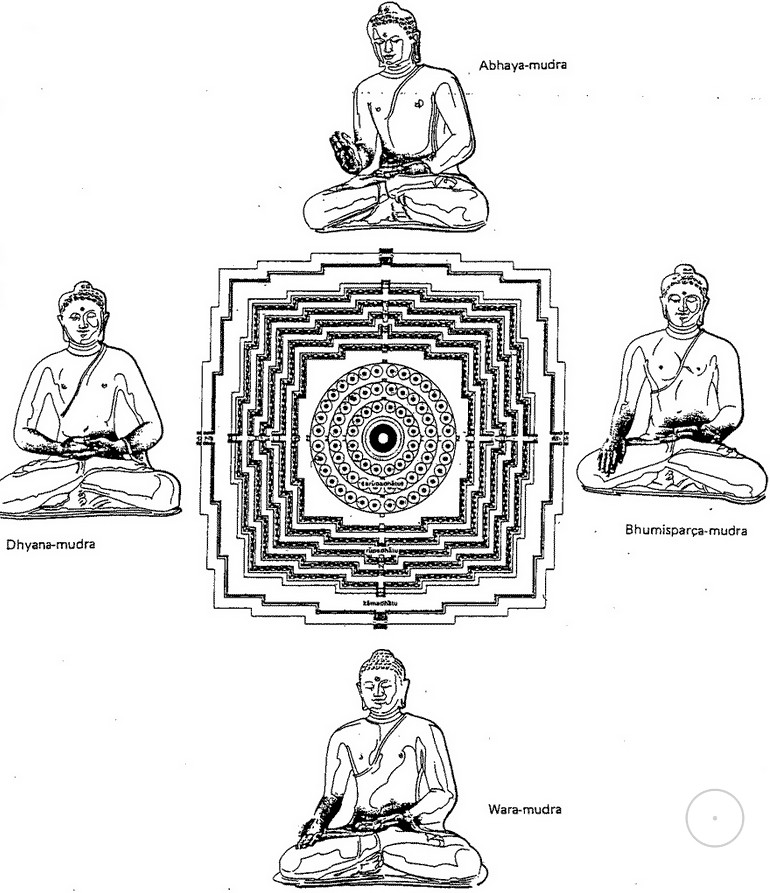
Borobudur in section:
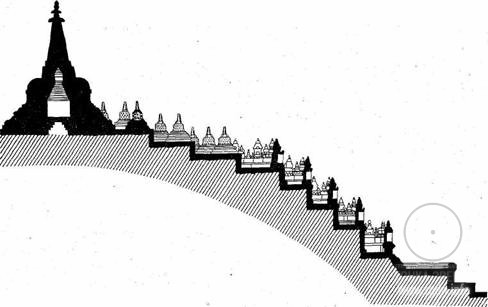
Chandi MENDUT and Chandi PAVON supplement the temple complex. They were built during the reign of King Indra (782–812 AD) of the Shailendra dynasty.
The whole temple complex symbolizes the way of a spiritual seeker from the mundane life to the Divine life, to the state of Buddha. In old times a big road led from Borobudur eastern entrance to Chandi Mendut, passing through Chandi Pavon. Along the entire road there were walls with numerous towers, niches, and sculptures.
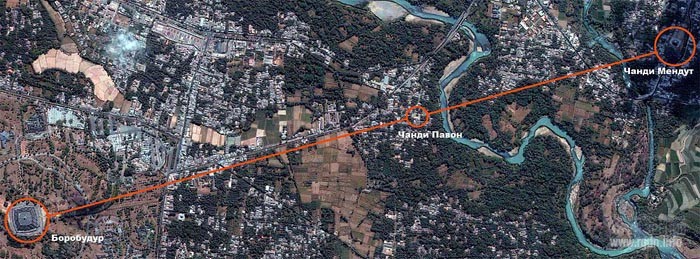
28)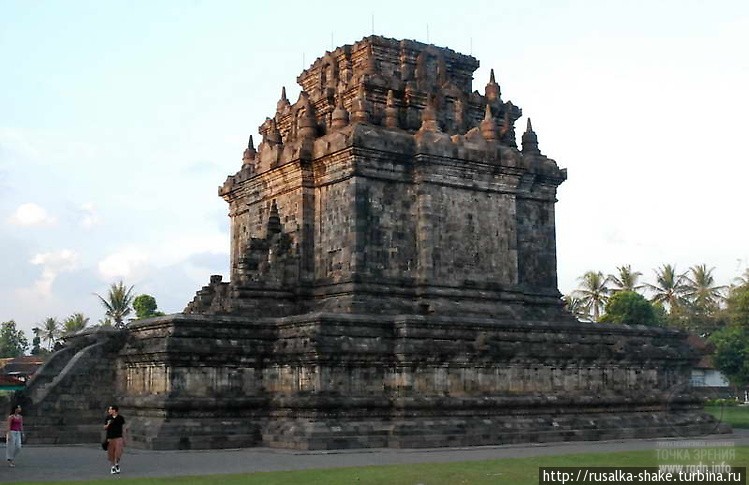 The layout of Chandi Mendut is traditional. It is a temple with a deity figure placed on a pedestal, intended for ritual processions. The walls contain thematic reliefs with scenes from Buddhist parables. The reliefs contain well-preserved images of Bodhisattvas. Inside Chandi Mendut itself there are three statues: Gautama Buddha in the middle, Bodhisattva Avalokiteśvara on the left, and a non-identified Bodhisattva on the right (there is an assumption that it is a statue of Vajrapani).
The layout of Chandi Mendut is traditional. It is a temple with a deity figure placed on a pedestal, intended for ritual processions. The walls contain thematic reliefs with scenes from Buddhist parables. The reliefs contain well-preserved images of Bodhisattvas. Inside Chandi Mendut itself there are three statues: Gautama Buddha in the middle, Bodhisattva Avalokiteśvara on the left, and a non-identified Bodhisattva on the right (there is an assumption that it is a statue of Vajrapani).
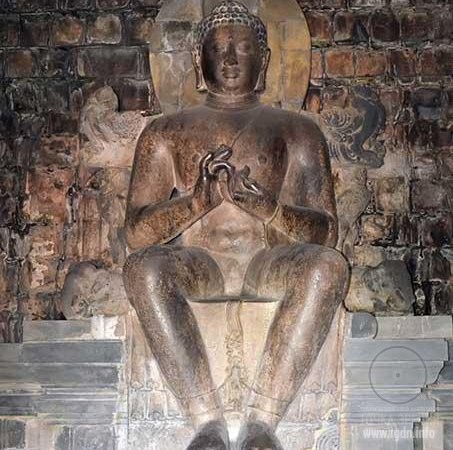
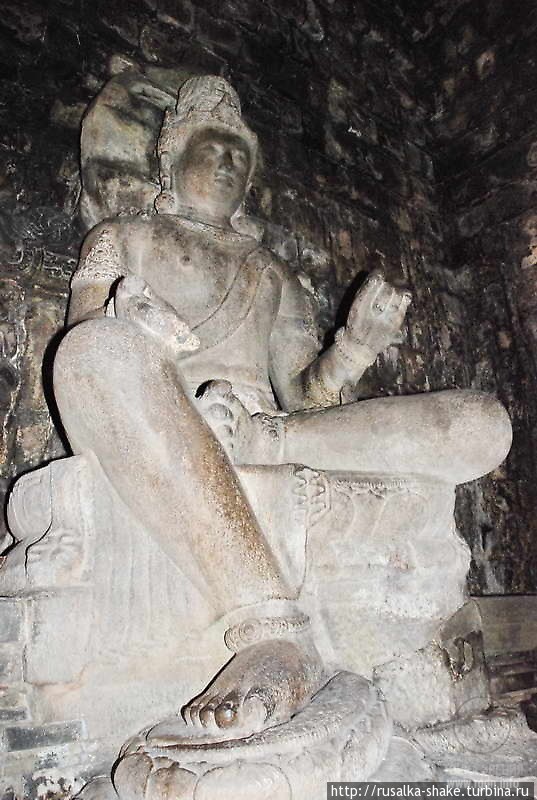
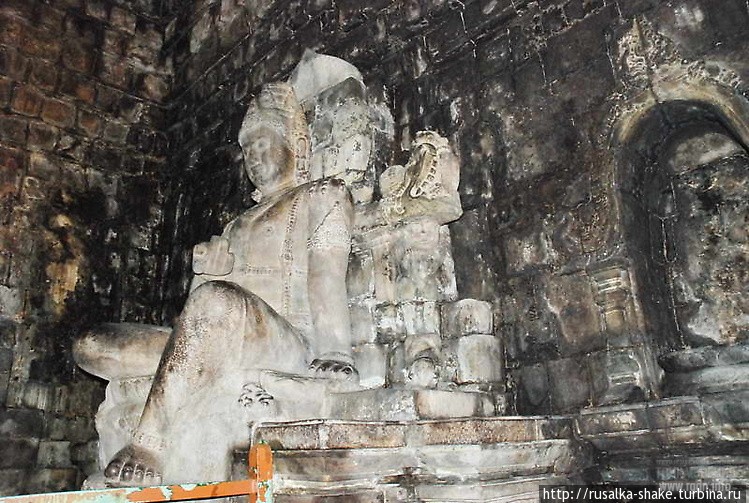
The most unusual thing is that Shakyamuni Buddha is sitting in a “European” or “royal” pose with his both feet put on the lotus pedestal and his knees widely parted, without any traces of clothes. Bodhisattvas are sitting in traditional poses with one foot under their body and the other foot lowered.
In traditional Buddhist iconography the image of the body part relating to genitals is always hidden by either a pose (asana) or pleats on the clothes (when Buddha is standing or lying). Hence, for adherents of canonical Buddhism the aforesaid depiction of Buddha is probably somewhat shocking.
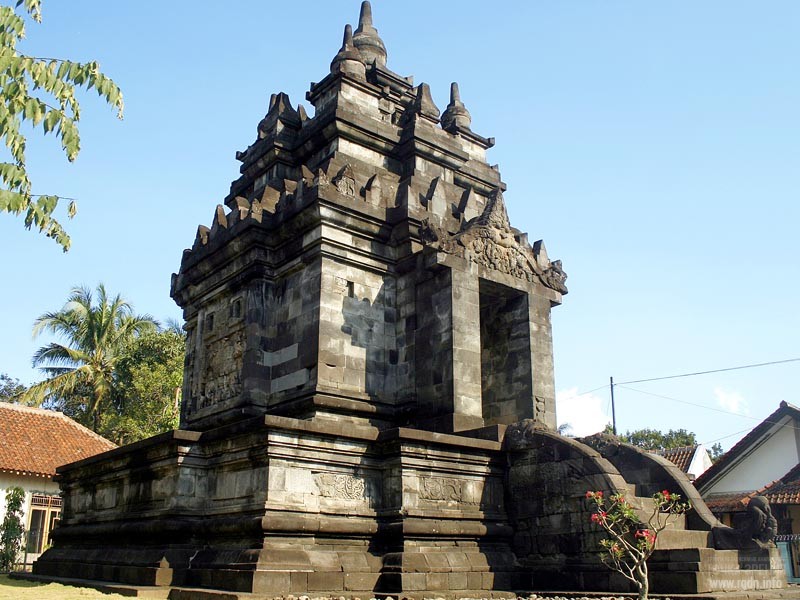
As it has been mentioned above, between Chandi Mendut and Borobudur there is the small Chandi Pavon, approximately 1,150 metres away from Mendut and 1,750 metres away from Borobudur.
Due to its small size, Pavon resembles a memorial monument. When the temple was found, it was in a very poor condition. Themes of decorative reliefs in Pavon include the “heavenly tree”, vessels with gifts, bearded dwarfs spilling necklaces, rings and jewels from boxes. Such themes are explained by the fact that Chandi Pavon is dedicated to the deity of wealth Kubera, who was usually depicted at entrances to temples.
Inner premises of the temple are trimmed with dark volcanic stone. Although no statues have been preserved in Chandi Pavon, it is possible to ascertain by outer wall reliefs that the temple once was dedicated to Kubera – the generous lord of luck and wealth. There are also extant images of Kalpataru – the mythical tree of desires in Hindu and Buddhist traditions. The desires ingrained in righteous thoughts and true faith will be fulfilled.

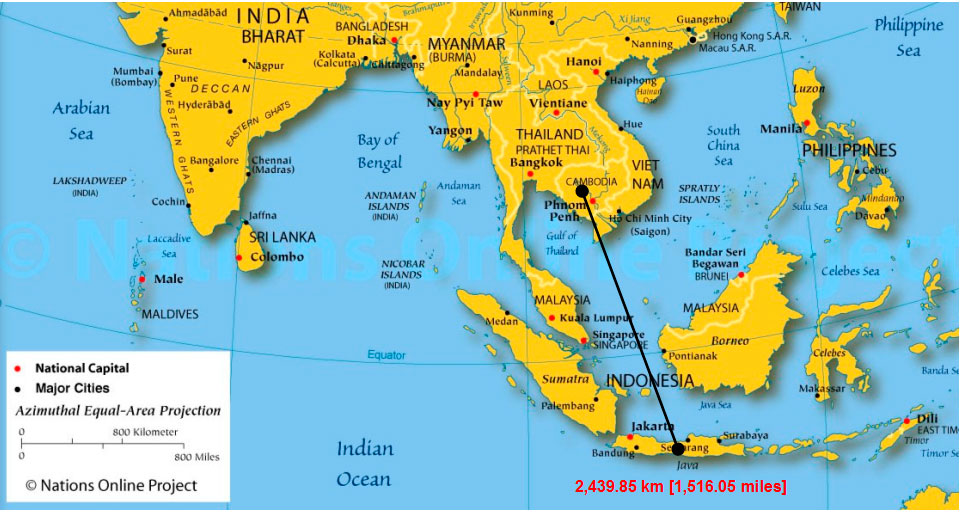
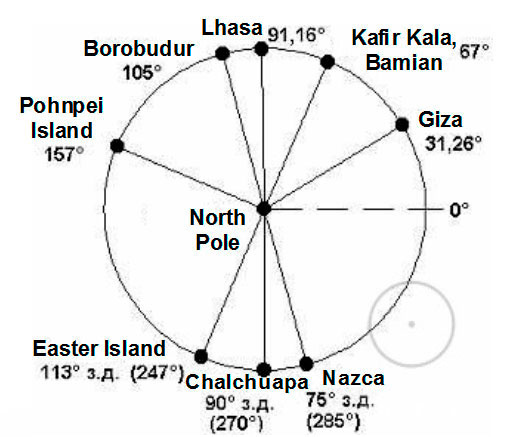
From the AllatRa book (pages 493, 502 – allatra.us):
... a symbolic designation of the Pyramid meditation (the full version of the symbol) was a square with a diagonal cross and an empty circle in its centre...
Figure 71. A mandala and a yantra
1) Mandala in the form of a circle with an indication of a square and a point in the centre, and a four-sided pyramid with six steps and fourfold division;
2) Kali Yantra (translated from Sanskrit, “kala” means “time”; this word originates from the Indo-European root that means spinning; a word that is close in its meaning in Russian is “kolo”); in Hindu mythology it means cyclical creations and destructions of the Universe, rotation of time in the concept of rebirth of the Soul and of a subject of fate.
Videos about Borobudur (Java, Indonesia):
Literature:
http://loveopium.ru/aziya/borobudur.html
http://zhistory.org.ua/histryd/borobud.htm
Prepared by Maxim Perepelitsa (Ukraine)
 Borobudur. The Buddhist stupa
votes:
130
Borobudur. The Buddhist stupa
votes:
130
|

Project Aim










Leave comment